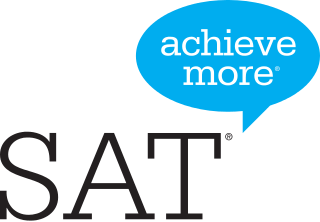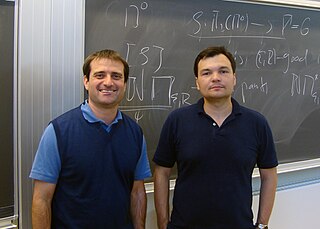Related Research Articles
Genius is a characteristic of original and exceptional insight in the performance of some art or endeavor that surpasses expectations, sets new standards for the future, establishes better methods of operation, or remains outside the capabilities of competitors. Genius is associated with intellectual ability and creative productivity, and may refer to a polymath who excels across many subjects.

An intelligence quotient (IQ) is a total score derived from a set of standardised tests or subtests designed to assess human intelligence. The abbreviation "IQ" was coined by the psychologist William Stern for the German term Intelligenzquotient, his term for a scoring method for intelligence tests at University of Breslau he advocated in a 1912 book.

The SAT is a standardized test widely used for college admissions in the United States. Since its debut in 1926, its name and scoring have changed several times. For much of its history, it was called the Scholastic Aptitude Test and had two components, Verbal and Mathematical, each of which was scored on a range from 200 to 800. Later it was called the Scholastic Assessment Test, then the SAT I: Reasoning Test, then the SAT Reasoning Test, then simply the SAT.
The g factor is a construct developed in psychometric investigations of cognitive abilities and human intelligence. It is a variable that summarizes positive correlations among different cognitive tasks, reflecting the fact that an individual's performance on one type of cognitive task tends to be comparable to that person's performance on other kinds of cognitive tasks. The g factor typically accounts for 40 to 50 percent of the between-individual performance differences on a given cognitive test, and composite scores based on many tests are frequently regarded as estimates of individuals' standing on the g factor. The terms IQ, general intelligence, general cognitive ability, general mental ability, and simply intelligence are often used interchangeably to refer to this common core shared by cognitive tests. However, the g factor itself is merely a mathematical construct indicating the level of observed correlation between cognitive tasks. The measured value of this construct depends on the cognitive tasks that are used, and little is known about the underlying causes of the observed correlations.
Intellectual giftedness is an intellectual ability significantly higher than average. It is a characteristic of children, variously defined, that motivates differences in school programming. It is thought to persist as a trait into adult life, with various consequences studied in longitudinal studies of giftedness over the last century. There is no generally agreed definition of giftedness for either children or adults, but most school placement decisions and most longitudinal studies over the course of individual lives have followed people with IQs in the top 2.5 percent of the population—that is, IQs above 130. Definitions of giftedness also vary across cultures.
Gifted education is a broad group of special practices, procedures, and theories used in the education of children who have been identified as gifted or talented.

David Cyril Geary is a United States cognitive developmental and evolutionary psychologist with interests in mathematical learning and sex differences. He is currently a Curators’ Professor and Thomas Jefferson Fellow in the Department of Psychological Sciences and Interdisciplinary Neuroscience Program at the University of Missouri in Columbia, Missouri.
Julian Cecil Stanley was an American psychologist. He was an advocate of accelerated education for academically gifted children. He founded the Johns Hopkins University Center for Talented Youth (CTY), as well as a related research project, the Study of Mathematically Precocious Youth (SMPY), whose work has, since 1980, been supplemented by the Julian C. Stanley Study of Exceptional Talent (SET), which provides academic assistance to gifted children. Stanley was also widely known for his classic book, coauthored with Donald Campbell, on the design of educational and psychological research - Experimental and Quasi-experimental Designs for Research.
Center for Talent Development (CTD), established in 1982, is a direct service and research center in the field of gifted education and talent development based at Northwestern University.
The Julian C. Stanley Study of Exceptional Talent (SET) is an outgrowth of the Study of Mathematically Precocious Youth (SMPY) at Johns Hopkins University. Founded in 1971 by Professor Julian Stanley, SMPY pioneered the concept of above-grade-level testing of middle school students, using the SAT to identify exceptionally talented mathematical reasoners, then offering rigorous academic programs for students who exhibit exceptional reasoning ability.

Evolutionary educational psychology is the study of the relation between inherent folk knowledge and abilities and accompanying inferential and attributional biases as these influence academic learning in evolutionarily novel cultural contexts, such as schools and the industrial workplace. The fundamental premises and principles of this discipline are presented below.

David J. Lubinski is an American psychology professor known for his work in applied research, psychometrics, and individual differences. His work has focussed on exceptionally able children: the nature of exceptional ability, the development of people with exceptional ability. He has published widely on the impact of extremely high ability on outputs such as publications, creative writing and art, patents etc. This work disconfirmed the "threshold hypothesis" which suggested that a certain minimum of IQ might be needed, but higher IQ did not translate into greater productivity or creativity. Instead his work shows that higher intelligence leads to higher outcomes with no apparent threshold or dropping off of its impact.

Jordan Stuart Ellenberg is an American mathematician who is a professor of mathematics at the University of Wisconsin–Madison. His research involves arithmetic geometry. He is also an author of both fiction and non-fiction writing.

Researchers have suggested a link between handedness and ability with mathematics. This link has been proposed by Geschwind, Galaburda, Annett, and Kilshaw. The suggested link is that a brain without extreme bias towards locating language in the left hemisphere would have an advantage in mathematical ability.
Camilla Persson Benbow is a Swedish-born (Scania) American educational psychologist and a university professor. She studies the education of intellectually gifted students.
Lenhard Ng is an American mathematician, working primarily on symplectic geometry. Ng is a professor of mathematics at Duke University.
The Gifted Education Research Resource Institute (GERI) is a multidimensional center dedicated to the study, discovery, and development of human potential. It was founded by John F. Feldhusen in 1977 and is situated in the College of Education, Purdue University in West Lafayette, Indiana. GERI's mission is holistic development of giftedness, creativity, and talent among individuals throughout their lifespan. This is accomplished through enrichment programs for talented youth, graduate programs for future scholars and leaders, professional development and coursework for educators, and ongoing research on the psychology of giftedness, creativity, and talent development. GERI faculty and staff work with P-12 educators in developing and improving services for gifted, creative, and talented children, as well as training school teachers and administrators in gifted education. In addition, GERI has developed several programs for talented youth. The Super Saturday program, a six-week enrichment program, was created in the spring of 1976. In 1977, GERI began Summer Residential Camps, aimed at providing a preview of college life to talented students.
The following outline is provided as an overview of and topical guide to human intelligence:

Jeremy Adam Kahn is an American mathematician. He works on hyperbolic geometry, Riemann surfaces and complex dynamics.
References
- ↑ Johns Hopkins University Center for Talented Youth (24 January 2012). "Study of Exceptional Talent". Study of Exceptional Talent website. Baltimore (MD): Johns Hopkins University Center for Talented Youth. Retrieved 16 May 2014.
- ↑ Study of Mathematically Precocious Youth (24 January 2012). "Study of Mathematically Precocious Youth". Study of Mathematically Precocious Youth website. Nashville (TN): Vanderbilt University Study of Mathematically Precocious Youth. Retrieved 16 May 2014.
- ↑ Lubinski, David; Benbow, Camilla Persson (2006). "Study of Mathematically Precocious Youth After 35 Years: Uncovering Antecedents for the Development of Math-Science Expertise" (PDF). Perspectives on Psychological Science. 1 (4): 316–345. doi:10.1111/j.1745-6916.2006.00019.x. PMID 26151798. S2CID 1739884 . Retrieved 16 May 2014.
- ↑ Kell, H. J.; Lubinski, D.; Benbow, C. P. (2013). "Who Rises to the Top? Early Indicators" (PDF). Psychological Science. 24 (5): 648–659. doi:10.1177/0956797612457784. ISSN 0956-7976. PMID 23531483. S2CID 7843030 . Retrieved 8 September 2015.
- ↑ Ferriman, Kimberley; Lubinski, David; Benbow, Camilla P. (2009). "Work preferences, life values, and personal views of top math/science graduate students and the profoundly gifted: Developmental changes and gender differences during emerging adulthood and parenthood" (PDF). Journal of Personality and Social Psychology. 97 (3): 517–532. doi:10.1037/a0016030. ISSN 1939-1315. PMID 19686005 . Retrieved 8 September 2015.
- ↑ Lubinski, D.; Benbow, C. P.; Kell, H. J. (2014). "Life Paths and Accomplishments of Mathematically Precocious Males and Females Four Decades Later" (PDF). Psychological Science. 25 (12): 2217–2232. doi:10.1177/0956797614551371. ISSN 0956-7976. PMID 25384550. S2CID 13144084 . Retrieved 8 September 2015.
- ↑ Benbow, Camilla Persson; Lubinski, David; Shea, Daniel L.; Eftekhari-Sanjani, Hossain (November 2000). "Sex differences in mathematical reasoning ability at age 13: Their status 20 years later" (PDF). Psychological Science. 11 (6): 474–80. CiteSeerX 10.1.1.557.7972 . doi:10.1111/1467-9280.00291. PMID 11202492. S2CID 23777202 . Retrieved 16 May 2014.
- ↑ Lubinski, David; Webb, Rose Mary; Morelock, Martha J.; Benbow, Camilla Persson (2001). "Top 1 in 10,000: A 10-Year Follow-Up of the Profoundly Gifted" (PDF). Journal of Applied Psychology. 86 (4): 718–729. doi:10.1037/0021-9010.86.4.718. PMID 11519655 . Retrieved 16 May 2014.